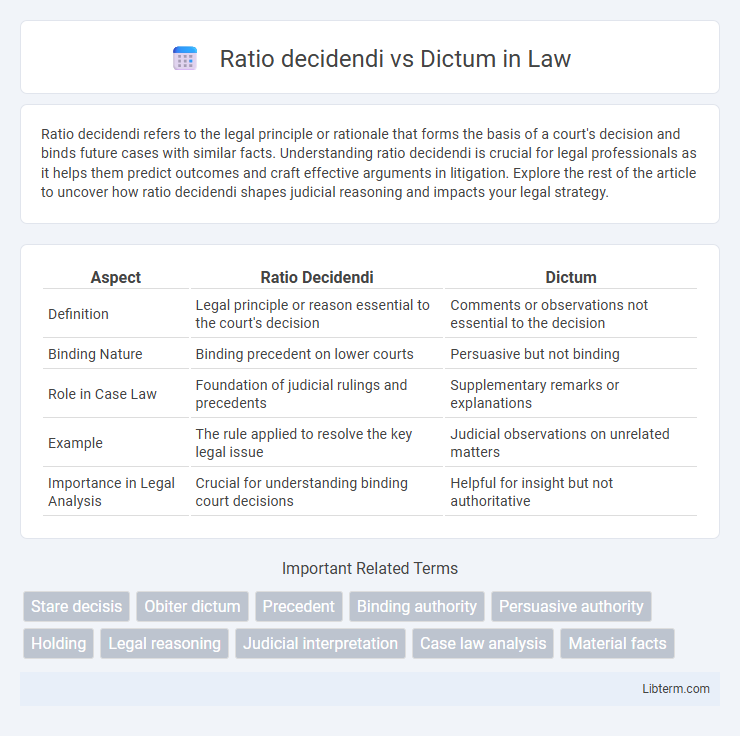Ratio decidendi refers to the legal principle or rationale that forms the basis of a court's decision and binds future cases with similar facts. Understanding ratio decidendi is crucial for legal professionals as it helps them predict outcomes and craft effective arguments in litigation. Explore the rest of the article to uncover how ratio decidendi shapes judicial reasoning and impacts your legal strategy.
Table of Comparison
| Aspect | Ratio Decidendi | Dictum |
|---|---|---|
| Definition | Legal principle or reason essential to the court's decision | Comments or observations not essential to the decision |
| Binding Nature | Binding precedent on lower courts | Persuasive but not binding |
| Role in Case Law | Foundation of judicial rulings and precedents | Supplementary remarks or explanations |
| Example | The rule applied to resolve the key legal issue | Judicial observations on unrelated matters |
| Importance in Legal Analysis | Crucial for understanding binding court decisions | Helpful for insight but not authoritative |
Introduction to Ratio Decidendi and Dictum
Ratio decidendi refers to the legal principle or rationale underlying a judicial decision, which forms the binding precedent for future cases. Dictum, or obiter dictum, consists of remarks or observations made by a judge that are not essential to the decision and therefore lack binding authority. Understanding the distinction between ratio decidendi and dictum is crucial for analyzing judicial opinions and their impact on case law development.
Definitions: Understanding Ratio Decidendi
Ratio decidendi refers to the legal principle or rule that forms the binding basis of a court's decision, serving as precedent for future cases. It encapsulates the essential reasoning necessary to resolve the legal issue presented, distinguishing it from obiter dictum, which includes remarks or observations not critical to the decision. Understanding ratio decidendi is crucial for interpreting case law and applying authoritative legal principles consistently across similar judicial matters.
Definitions: Understanding Dictum (Obiter Dicta)
Dictum, or obiter dicta, refers to statements made by judges in a legal opinion that are not essential to the decision and therefore not legally binding as precedent. These expressions often provide insight or commentary on related legal issues but do not form the ratio decidendi, which constitutes the binding legal principle derived from the case facts. Distinguishing dictum from ratio decidendi is crucial for understanding the authoritative weight of judicial decisions in common law systems.
Historical Origins and Development
The distinction between ratio decidendi and dictum originates from the classical development of common law jurisprudence, with ratio decidendi referring to the legal principle essential to a court's decision, while dictum encompasses extraneous observations made by judges. Historically, ratio decidendi evolved through case law as courts sought to establish binding precedents, cementing its role in legal reasoning and doctrine development. Dictum, though influential in shaping legal thought, remains non-binding commentary, reflecting the judiciary's interpretative insights beyond the core legal rule.
Key Differences Between Ratio Decidendi and Dictum
Ratio decidendi refers to the legal principle or rule of law on which a court's decision is based, serving as binding precedent in future cases, while dictum comprises statements or observations made by a judge that are not essential to the decision and hold persuasive, but not binding, authority. The key difference lies in their judicial weight: ratio decidendi forms the core reasoning that must be followed by lower courts, whereas dictum offers additional commentary or illustrative examples without obligatory influence. Understanding this distinction is crucial for legal practitioners when interpreting case law and applying precedents in litigation.
Role in Judicial Precedent and Case Law
Ratio decidendi constitutes the legally binding principle or rule derived from the facts and legal issues of a case, forming the authoritative basis for future judicial decisions and establishing binding precedent. Dictum, or obiter dictum, consists of remarks or observations made by a judge that are not essential to the case's outcome and thus hold persuasive but non-binding authority in subsequent case law. Courts rely on ratio decidendi to ensure consistency and predictability in judicial precedent, while dicta provide guidance that may influence but does not constrain future rulings.
Methods of Identifying Ratio Decidendi
The ratio decidendi refers to the legal principle or rule essential to the court's decision, while dictum comprises non-binding statements or observations. Methods of identifying ratio decidendi include analyzing the facts crucial to the court's conclusion, examining the judgment's rationale, and distinguishing binding elements from obiter dicta. Precedential weight depends on correctly pinpointing the ratio, which guides future case law and judicial consistency.
Significance of Dictum in Legal Reasoning
Dictum refers to statements in a judicial opinion that are not essential to the decision and therefore lack binding authority, but they hold persuasive value in legal reasoning by offering insight or guidance on broader legal principles. While ratio decidendi is the core legal principle that forms the binding precedent, dictum can influence future cases by illuminating interpretative approaches or highlighting considerations courts may find persuasive. The significance of dictum lies in its ability to shape legal discourse and provide context for evolving jurisprudence without imposing obligatory rules.
Impact on Future Legal Decisions
Ratio decidendi forms the binding legal principle of a judicial decision, directly influencing future case law and ensuring consistency in legal interpretation. Dictum, while persuasive, lacks binding authority and serves primarily as guidance or commentary, often shaping but not controlling subsequent rulings. Courts prioritize ratio decidendi to establish precedent, while dicta may inform judicial reasoning without mandating outcomes.
Conclusion: Importance in Legal Analysis
Ratio decidendi represents the binding legal principle derived from a court's judgment, serving as precedent in subsequent cases, while dictum comprises non-binding observations or comments that do not establish a legal rule. The conclusion of a court's decision hinges on the ratio decidendi, which is crucial for legal analysis because it guides judges and lawyers in interpreting and applying the law consistently. Understanding the distinction ensures accurate identification of authoritative precedents versus persuasive but non-binding remarks in judicial reasoning.
Ratio decidendi Infographic

 libterm.com
libterm.com